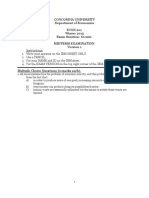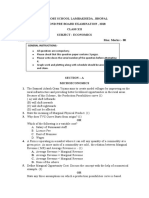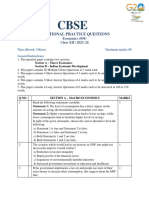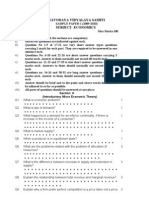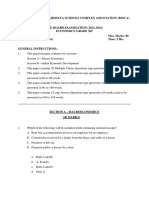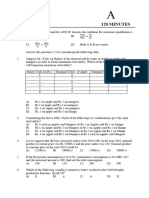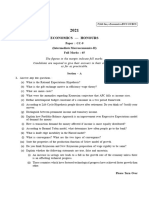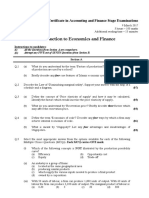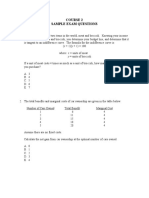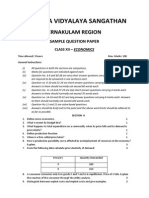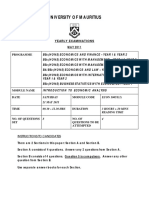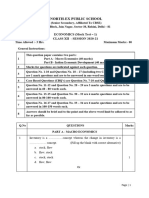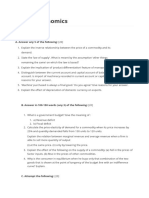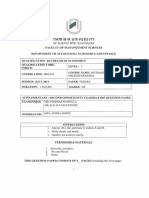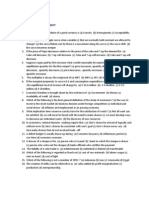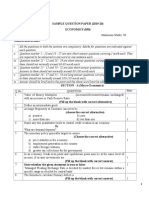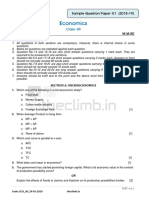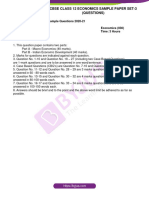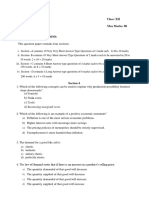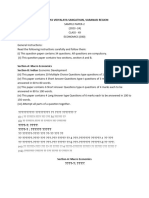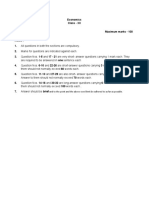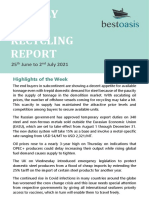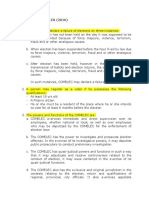Sample Question Paper Class XII (2017-18) Economics (030) Mm. 80 Time: 3 Hours
Sample Question Paper Class XII (2017-18) Economics (030) Mm. 80 Time: 3 Hours
Uploaded by
Gaurav VermaCopyright:
Available Formats
Sample Question Paper Class XII (2017-18) Economics (030) Mm. 80 Time: 3 Hours
Sample Question Paper Class XII (2017-18) Economics (030) Mm. 80 Time: 3 Hours
Uploaded by
Gaurav VermaOriginal Description:
Original Title
Copyright
Available Formats
Share this document
Did you find this document useful?
Is this content inappropriate?
Copyright:
Available Formats
Sample Question Paper Class XII (2017-18) Economics (030) Mm. 80 Time: 3 Hours
Sample Question Paper Class XII (2017-18) Economics (030) Mm. 80 Time: 3 Hours
Uploaded by
Gaurav VermaCopyright:
Available Formats
Sample Question Paper
Class XII (2017-18)
Economics (030)
MM. 80 Time: 3 Hours
Q.No. SECTION A : MICROECONOMICS Marks
1 Which of the following is a statement of normative nature in economics? 1
a) Economics is study of choices/alternatives.
b) Government should be concerned with how to reduce unemployment
c) According to an estimate, in spite of severe shortage, more than 10% of houses
in Indian cities are lying vacant.
d) Accommodation of Refugees is posing a big problem for the Europe
2 Define Marginal Physical Product. 1
3 A firm is operating with a Total Variable Cost of 500 when 5 units of the given 1
output are produced and the Total Fixed Costs are 200, what will be the Average
Total Cost of producing 5 units of output?
i) 140 ii) 100 iii ) 120 iv) 300
4 In an imperfectly competitive market, if the Total Revenue is maximum, Marginal 1
Revenue will be ......................
5 State and discuss any two factors that will shift the Production Possibility Frontier 3
(PPF)to the right.
Or
Draft a hypothetical schedule for a straight line Production Possibility Curve.
6 Giving reason, state the impact of each of following on demand curve of a normal 3
good ‘X’ if
i) Price of its complementary good falls.
ii) News reports claims that consumption of product X has harmful effect
on human health.
iii) Income of consumer increases,
7 a. Arrange the following coefficients of price elasticity of demand in ascending order: 1
-0.87, -0.53, -3.1, -0.80
b. Comment upon the degree of elasticity of demand for commodity X,if the price of 3
the commodity falls from 28 per unit to 23 per unit and its quantity demanded rises
from 50 units to 100 units.
8 What is meant by Price Floor? Discuss in brief, any one consequence of imposition of 4
floor price above equilibrium price with help of a diagram.
. Or
How is the price of a commodity determined in a perfectly competitive market?
Explain with help of a diagram.
9 Explain how the following factors affect the supply of the commodity (any two) 4
a) Price of factor inputs b) State of technology c) Government taxation
Policy
10 a) A consumer, Mr Aman is in state of equilibrium consuming two goods X and Y, 2
with given prices Px and Py . What will happen if ?
b) Identify which of the following is not true for the Indifference Curves theory. Give 4
valid reasons for choice of your answer:
a. Lower indifference curve represents lower level of satisfaction.
b. Two indifference curves can intersect each other.
c. Indifference curve must be convex to origin at the point of tangency with
the budget line at the consumer’s equilibrium.
d. Indifference curves are drawn under the ordinal approach to consumer
equilibrium.
OR
A consumer has total money income of 500 to be spent on two goods X and Y with
prices of 50 and 10 per unit respectively. On the basis of the given information,
answer the following questions:
a. Give the equation of the budget line for the consumer. 1
b. What is the value of slope of the budget line? 1
c. How many units can the consumer buy if he is to spend all his money
income on good X? 2
d. How does the budget line change if there is a 50% fall in price of good Y? 2
11 a) Why is Total Variable Cost curve inverse S- shaped? 2
b) What is Average Fixed Cost of a firm? Why is an Average Fixed Cost Curve a 4
rectangular Hyperbola? Explain with help of a diagram.
12 Suppose the value of demand and supply curves of a Commodity-X is given by the 6
following two equations simultaneously:
Qd = 200 –10p Qs = 50 + 15p
i) Find the equilibrium price and equilibrium quantity of commodity X.
ii) Suppose that the price of a factor inputs used in producing the
commodity has changed, resulting in the new supply curve given by the
equation
Qs’ = 100 + 15p
Analyse the new equilibrium price and new equilibrium quantity as
against the original equilibrium price and equilibrium quantity.
SECTION B : MACROECONOMICS
13 Define money supply? 1
14 State one fiscal measure that can be used to reduce the gap between rich and poor. 1
15 Define the capital receipts of a government. 1
16 From the following data calculate Fiscal Deficit 1
S.No Item • in Billions
1 Capital Receipt 68
2 Revenue Expenditure 160
3 Interest Payment 20
4 Borrowings 32
5 Tax Revenue 50
6 Non- Tax revenue 10
17 Estimate the value of ex-ante AD, when autonomous investment and consumption 3
expenditure (A) is 50 crores, and MPS is 0.2 and level of income is 300 crores.
Or
Calculate Multiplier when MPC is and . From the calculations establish the relation
between size of Multiplier and size of MPC?
18 Discuss the significance of 45 degree line in Keynesian Economics. 3
19 Elaborate ‘economic growth’ as objective of government budget. 4
20 Use following information of an imaginary country: 4
Year 2014 – 2015 2015– 2016 2016 - 2017
Nominal 6.5 8.4 9
GDP
GDP deflator 100 140 125
i) For which year is real GDP and nominal GDP same and why?
ii) Calculate Real GDP for the given years. Is there any year for which Real GDP falls?
21 How will ‘Reverse Repo Rate’ and ‘Open Market Operations’ control excess money 4
supply in an economy?
Or
Illustrate with the help of a hypothetical numerical example the process of credit
creation.
22 a) Define Externality. 2
b) Find National Income from following using expenditure method 4
• (in crores)
1 Current transfers from rest of the world 50
2 Net Indirect taxes 100
3 Net Exports - 25
4 Rent 90
5 Private Final Consumption Expenditure 900
6 Net Domestic Capital Formation 200
7 Compensation of Employees 500
8 Net Factor Income from Abroad - 10
9 Government Final Consumption Expenditure 400
10 Profit 220
11 Mixed Income of Self Employed 400
12 Interest 230
Or
Will the following factor income be included in domestic factor income of India? Give
reasons for your answer:-
(i) Compensation of employees to the resident of Japan working in Indian
embassy in Japan.
(ii) Payment of fees to a Chartered Accountant by a firm
(iii)Rent received by an Indian resident from Russian embassy in India.
(iv) Compensation given by insurance company to an injured worker.
23 State whether the following statements are true or false. Give valid reasons for your 6
answers.
(i) Unplanned inventories accumulate when planned investment is less than planned
saving.
(ii) Deflationary gap exists when aggregate demand is greater than aggregate supply at
full employment level.
(iii) Average propensity to save can never be negative.
24 a) ‘Devaluation and Depreciation of currency is one and the same thing’. Do you 3
agree? How do they affect the exports of a country?
b) What is meant by ‘official reserve transactions’? Discuss their importance in 3
Balance of Payments.
You might also like
- Institutional Markets and Government Markets and How Institutional and Government Buyers Make Their Buying DecisionsDocument5 pagesInstitutional Markets and Government Markets and How Institutional and Government Buyers Make Their Buying DecisionsHasan Afaque80% (5)
- Microeconomics End Term Exam Academic Year: 2021-22 Time: 2 HoursDocument7 pagesMicroeconomics End Term Exam Academic Year: 2021-22 Time: 2 HoursKartik GurmuleNo ratings yet
- Econ 201 Past Midterm 2Document13 pagesEcon 201 Past Midterm 2SooHan MoonNo ratings yet
- Sample Question Paper Class XII (2017-18) Economics (030) Mm. 80 Time: 3 HoursDocument13 pagesSample Question Paper Class XII (2017-18) Economics (030) Mm. 80 Time: 3 Hourstheunsung taleNo ratings yet
- CBSE Class 12 Sample Paper 2018 - EconomicsDocument4 pagesCBSE Class 12 Sample Paper 2018 - EconomicsSundayNo ratings yet
- General InstructionsDocument4 pagesGeneral InstructionsAditya ShrivastavaNo ratings yet
- Cbse Class 12 Economics - PQDocument21 pagesCbse Class 12 Economics - PQMurtaza JamaliNo ratings yet
- Economics PQDocument9 pagesEconomics PQash kathumNo ratings yet
- ECO-12 CBSE Additional Practice Questions 2023-24Document20 pagesECO-12 CBSE Additional Practice Questions 2023-24Sadjaap SinghNo ratings yet
- EconomicsDocument9 pagesEconomicsSimha SimhaNo ratings yet
- Fps Preboard Xii - Eco Set BDocument9 pagesFps Preboard Xii - Eco Set BNitin BajpaiNo ratings yet
- Test 10 Macro Full CourseDocument4 pagesTest 10 Macro Full CourseanxyisminecraftNo ratings yet
- Sample Paper 1Document6 pagesSample Paper 1Umesh BhardwajNo ratings yet
- Class 12 Sahodaya Pre Board QP Economics Set ADocument23 pagesClass 12 Sahodaya Pre Board QP Economics Set AAnshika GangwarNo ratings yet
- Introduction To Economics and FinanceDocument4 pagesIntroduction To Economics and FinanceHaseeb AhmadNo ratings yet
- BB 107 Supplementary Exam Summer 2020 Q (Set A) (Online)Document6 pagesBB 107 Supplementary Exam Summer 2020 Q (Set A) (Online)Brewell CoNo ratings yet
- Economics Prepboard 1SET - BDocument6 pagesEconomics Prepboard 1SET - Bjainehalll28No ratings yet
- ECONOMICS-2019 SetDocument15 pagesECONOMICS-2019 Setswafwan yousafNo ratings yet
- CU-2021 B.A. B.sc. (Honours) Economics Semester-IV Paper-CC-9 QPDocument2 pagesCU-2021 B.A. B.sc. (Honours) Economics Semester-IV Paper-CC-9 QPriyaranisingh20208817No ratings yet
- Introduction To Economics and FinanceDocument4 pagesIntroduction To Economics and FinancesaimNo ratings yet
- ECF100 2024 Semester 1 Final ExamDocument9 pagesECF100 2024 Semester 1 Final ExamchilupeesnartNo ratings yet
- Eco112 2017 ExamDocument7 pagesEco112 2017 Examdeklerkkimberey45No ratings yet
- Class 12th Economic Sample Paper 2024-25Document10 pagesClass 12th Economic Sample Paper 2024-251rajurastogi1No ratings yet
- Course 2 Sample Exam Questions: y Units of BroccoliDocument47 pagesCourse 2 Sample Exam Questions: y Units of BroccoliEden ZapicoNo ratings yet
- 12th Economics Half YearlyDocument13 pages12th Economics Half YearlyDeepak ChandraNo ratings yet
- 12 Economics Pre Board 2 Set ADocument5 pages12 Economics Pre Board 2 Set Amcsworkshop777No ratings yet
- Kendriya Vidyalaya Sangathan: Ernakulam RegionDocument4 pagesKendriya Vidyalaya Sangathan: Ernakulam RegionSoniya Omir VijanNo ratings yet
- ISWK XII Economics (030) QP & MS REHEARSAL 1 (23-24)Document15 pagesISWK XII Economics (030) QP & MS REHEARSAL 1 (23-24)hanaNo ratings yet
- MS Eco Set 5Document6 pagesMS Eco Set 5Vaidehi BagraNo ratings yet
- University of Mauritius: Instructions To CandidatesDocument8 pagesUniversity of Mauritius: Instructions To Candidates80tekNo ratings yet
- KV Jaipur 10 SQP 2023-24Document121 pagesKV Jaipur 10 SQP 2023-24Sandesh kumar SharmaNo ratings yet
- XII Economics Mock Test 1Document10 pagesXII Economics Mock Test 1LPS ANJALI SHARMANo ratings yet
- STD XII Economics: A. Answer Any 5 of The FollowingDocument3 pagesSTD XII Economics: A. Answer Any 5 of The FollowingDean WoodNo ratings yet
- ECO 102 - Assignment IIDocument2 pagesECO 102 - Assignment IISayeeda JahanNo ratings yet
- Model Question Paper: EconomicsDocument3 pagesModel Question Paper: Economicssharathk916No ratings yet
- This Question Paper Contains Two PartsDocument17 pagesThis Question Paper Contains Two PartsRavikumar BalasubramanianNo ratings yet
- Imi611s - Intermediate Microeconomics - 2ND Opp - July 2019Document5 pagesImi611s - Intermediate Microeconomics - 2ND Opp - July 2019Smart Academic solutionsNo ratings yet
- Spring Final Test 2022 (Questions) v1.1Document8 pagesSpring Final Test 2022 (Questions) v1.1rozinskiy.serNo ratings yet
- Economics 2006 Postume TestDocument16 pagesEconomics 2006 Postume Testvaluba01No ratings yet
- Problem Set - 2015 MACRODocument3 pagesProblem Set - 2015 MACRODuge GaltsaNo ratings yet
- CBSE Class 12 Economics Sample Question Paper 2020Document12 pagesCBSE Class 12 Economics Sample Question Paper 2020NeerajNo ratings yet
- Economics SQP20Document6 pagesEconomics SQP209227aryansajsNo ratings yet
- ECO 111 - Tutorial Questions - October 2021Document8 pagesECO 111 - Tutorial Questions - October 2021Nɩʜɩɭɩstic Ucʜɩʜʌ SʌsʋĸɘNo ratings yet
- EconomicsDocument157 pagesEconomicsportableawesomeNo ratings yet
- Class 12 CBSE Sample Paper EconomicsDocument8 pagesClass 12 CBSE Sample Paper Economicsyazhinirekha4444No ratings yet
- 8989economics 12 - 2019Document10 pages8989economics 12 - 2019Vs SivaramanNo ratings yet
- Cbse Class 12 Economics Sample Paper Set 3 QuestionsDocument6 pagesCbse Class 12 Economics Sample Paper Set 3 QuestionsPhototronixNo ratings yet
- Tayabur Rahman - Final - AutumnDocument10 pagesTayabur Rahman - Final - AutumnTayabur RahmanNo ratings yet
- Model Paper Economics 12thDocument5 pagesModel Paper Economics 12thvaishnavipole12commerNo ratings yet
- Sample Paper 2Document19 pagesSample Paper 2balajayalakshmi96No ratings yet
- Cbse Class 12 Economics Sample Paper Set 1 QuestionsDocument6 pagesCbse Class 12 Economics Sample Paper Set 1 QuestionsSaturo GojoNo ratings yet
- Doc-20231219-Wa0005 231221 211706Document13 pagesDoc-20231219-Wa0005 231221 211706Paawni GuptaNo ratings yet
- T4 Business Economics Q&ADocument14 pagesT4 Business Economics Q&ABiplob K. SannyasiNo ratings yet
- Pb23eco02 QPDocument7 pagesPb23eco02 QPAfiya NazimNo ratings yet
- EconomicsDocument113 pagesEconomicsdevanshsoni4116No ratings yet
- 12 Economics Eng PP 2023 24 1Document8 pages12 Economics Eng PP 2023 24 1Shivansh JaiswalNo ratings yet
- Macro Asgmt 2Document3 pagesMacro Asgmt 2Girma erenaNo ratings yet
- Economics Class - XII Time - 3 Hours. Maximum Marks - 100 Notes: 1. 2. 3. 4. 5. 6. 7Document12 pagesEconomics Class - XII Time - 3 Hours. Maximum Marks - 100 Notes: 1. 2. 3. 4. 5. 6. 7sahilNo ratings yet
- Sem - V Eco & Maths SuggestionDocument21 pagesSem - V Eco & Maths SuggestionPritam Kumar PaulNo ratings yet
- ECO2144 Micro Theory I 2007 Final ExamDocument5 pagesECO2144 Micro Theory I 2007 Final ExamTeachers OnlineNo ratings yet
- Problem Set 11 SolutionsDocument4 pagesProblem Set 11 Solutionspenar38488No ratings yet
- Weekly Ship Recycling ReportDocument7 pagesWeekly Ship Recycling ReportMohammed FaruqueNo ratings yet
- FTI Leonid Nevzlin Report 15.11.2022Document19 pagesFTI Leonid Nevzlin Report 15.11.2022So LoNo ratings yet
- PNC Menon +91 99012 34604: Architects Name 1 2 3 4 5 6 7 8 9 10 11 12 13 14Document17 pagesPNC Menon +91 99012 34604: Architects Name 1 2 3 4 5 6 7 8 9 10 11 12 13 14prashantsinghhattNo ratings yet
- How To Get Closer To GodDocument3 pagesHow To Get Closer To Godfonzycarlos359505No ratings yet
- CPC Assignment-2Document13 pagesCPC Assignment-2afaq khanNo ratings yet
- HUL213 SyllabusDocument3 pagesHUL213 SyllabuschandramgpmNo ratings yet
- 2019032212Document33 pages2019032212mehNo ratings yet
- AFMC MBBS Information Brochure 2022Document28 pagesAFMC MBBS Information Brochure 2022Anju KumariNo ratings yet
- Exegesis Wedding at Cana John 2 1-12 PDFDocument100 pagesExegesis Wedding at Cana John 2 1-12 PDFAndrei Buterchi100% (1)
- Guidance On Regulation of Digital Securities Activities in AdgmDocument32 pagesGuidance On Regulation of Digital Securities Activities in AdgmAhmed BoumedienneNo ratings yet
- Pakistan Airport Passenger DataDocument4 pagesPakistan Airport Passenger DataRajesh BhaskaranNo ratings yet
- DGR REGULATION - Section 18 - Dangerous Goods by Air - Edition 2.0Document49 pagesDGR REGULATION - Section 18 - Dangerous Goods by Air - Edition 2.0kecildaimNo ratings yet
- DM - Module - 3 - PPT - Disasters and Development SEP 2021Document102 pagesDM - Module - 3 - PPT - Disasters and Development SEP 2021121810302054 A NEERAJNo ratings yet
- The RattrapDocument8 pagesThe RattrapMB. GamingsNo ratings yet
- Ma1 Villamor Finals - ModuleDocument13 pagesMa1 Villamor Finals - ModuleDanielNo ratings yet
- MGTS F211 - Mide Sem QPDocument3 pagesMGTS F211 - Mide Sem QPSimran sandhuNo ratings yet
- Judges Vs JuriesDocument3 pagesJudges Vs JuriesRojan Alexei GranadoNo ratings yet
- Apel Finals SamplexDocument6 pagesApel Finals SamplexAustine Clarese VelascoNo ratings yet
- FIR Against All Illegal Slaughter Houses in Gurgaon by Naresh Kadian.Document18 pagesFIR Against All Illegal Slaughter Houses in Gurgaon by Naresh Kadian.Naresh KadyanNo ratings yet
- IT Audit ChecklistDocument40 pagesIT Audit ChecklistPatricia Zhonga100% (6)
- ThelastduchessannotationsDocument2 pagesThelastduchessannotationsapi-574396440No ratings yet
- Toate Subiectele Sunt Obligatorii. Se Acord Timpul Efectiv de Lucru Este de 3 OreDocument1 pageToate Subiectele Sunt Obligatorii. Se Acord Timpul Efectiv de Lucru Este de 3 OreSimona ButeNo ratings yet
- Bangladesh BSCDocument8 pagesBangladesh BSCAhmad BilalNo ratings yet
- English Short Stories Random Pages Sample2Document22 pagesEnglish Short Stories Random Pages Sample2Àhmed R. Farrag50% (2)
- Amal SamsungDocument13 pagesAmal SamsungAboubakr SoultanNo ratings yet
- BA PresentationDocument23 pagesBA PresentationRajpurohit Jigar SinghNo ratings yet
- MC34063 STmicroDocument23 pagesMC34063 STmicroFady HachemNo ratings yet
- Icm Project ReportDocument107 pagesIcm Project ReportJibin anandNo ratings yet


